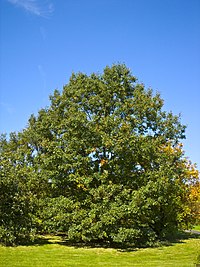
Photo from wikipedia
The exclusion of anthropogenic fire is a primary factor responsible for the ‘mesophication’ of eastern oak (Quercus) forests and resultant oak regeneration problems. Consequently, the reintroduction of fire is increasingly… Click to show full abstract
The exclusion of anthropogenic fire is a primary factor responsible for the ‘mesophication’ of eastern oak (Quercus) forests and resultant oak regeneration problems. Consequently, the reintroduction of fire is increasingly used to promote the establishment and growth of oak and hickory (Carya) and control competition from shade-tolerant species (e.g., red maple (Acer rubrum)) in the forest understory. In this study, we examined the effects of fire frequency on the abundance of prominent species in the woody regeneration layer in oak-dominated forests of eastern Kentucky. Treatments included: (1) fire-excluded (FE); (2) frequent fire (FF) – five burns over nine years, and (3) less-frequent fire (LFF) – two burns over seven years. Prior to burning (2002) and again five and seven growing seasons following the cessation of burning in the FF and LFF treatments (2015), respectively, we inventoried tree species in the woody regeneration layer into three size classes: (1) small seedlings (stems < 0.6 m), (2) large seedlings (≥0.6 m and <1.2 m) and (3) small saplings (≥1.2 m and <3.8 cm diameter at breast height). Pre- and postburn, the regeneration layer was dominated by non-Oak-Hickory species, and although Oak-Hickory regeneration was abundant the majority of stems were <0.6 m. For Oak-Hickory, significant treatment effects were limited to the large seedling and small sapling size classes. For large Oak-Hickory seedlings, density was significantly greater in the LFF than FE treatment. For small Oak-Hickory saplings, density in the LFF treatment was ∼17 and ∼4 times greater than in the FE and FF treatments, respectively. This study provides support for the notion that fire-free periods may be more of a factor controlling the abundance and composition of the woody regeneration layer than simply the number of burns. However, despite greater stem density, the fate of the Oak-Hickory regeneration layer that developed in response to the LFF treatment is uncertain, as the density of non-oak competitors remains high. Additional treatments (e.g., targeted herbicide application, additional burning) may be necessary to reduce the abundance of non-oak species and increase the likelihood of continued recruitment Oak-Hickory should natural or silvicultural release events occur.
Journal Title: Forest Ecology and Management
Year Published: 2017
Link to full text (if available)
Share on Social Media: Sign Up to like & get
recommendations!